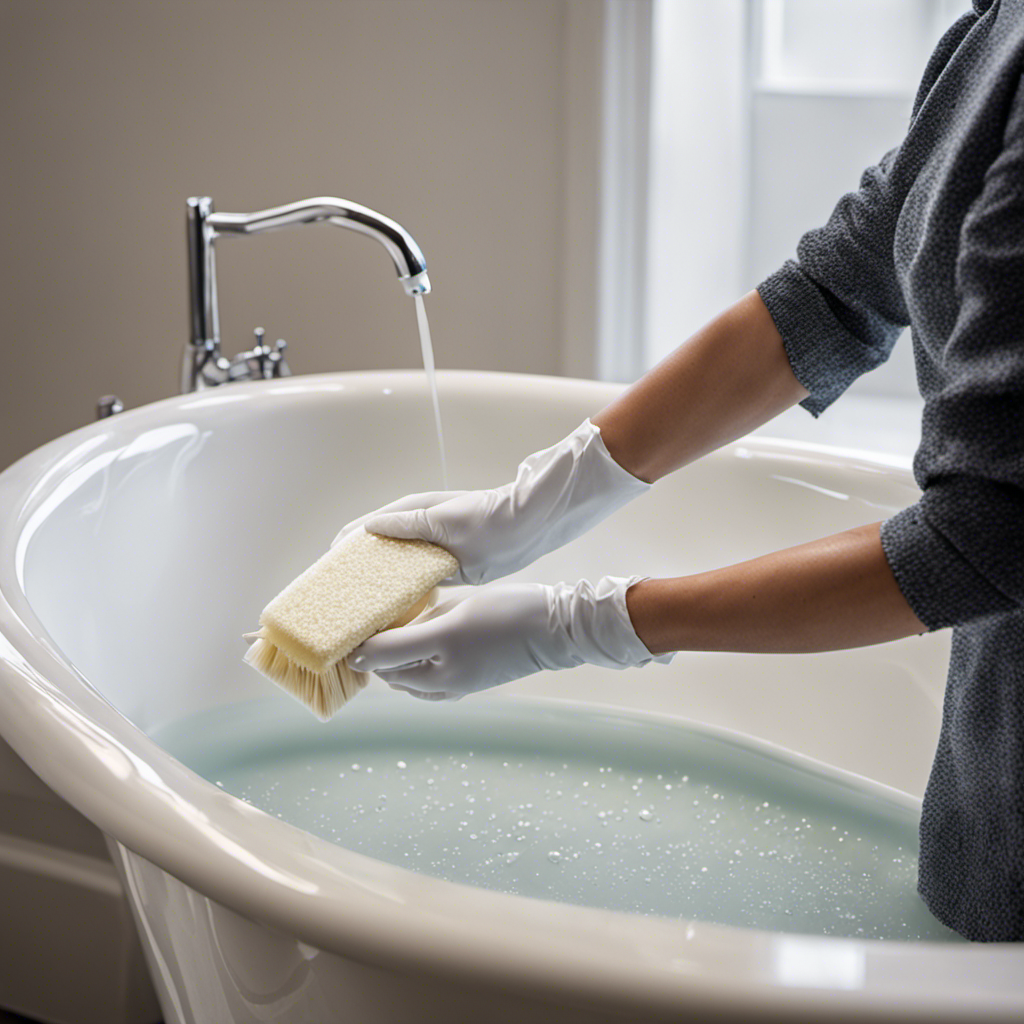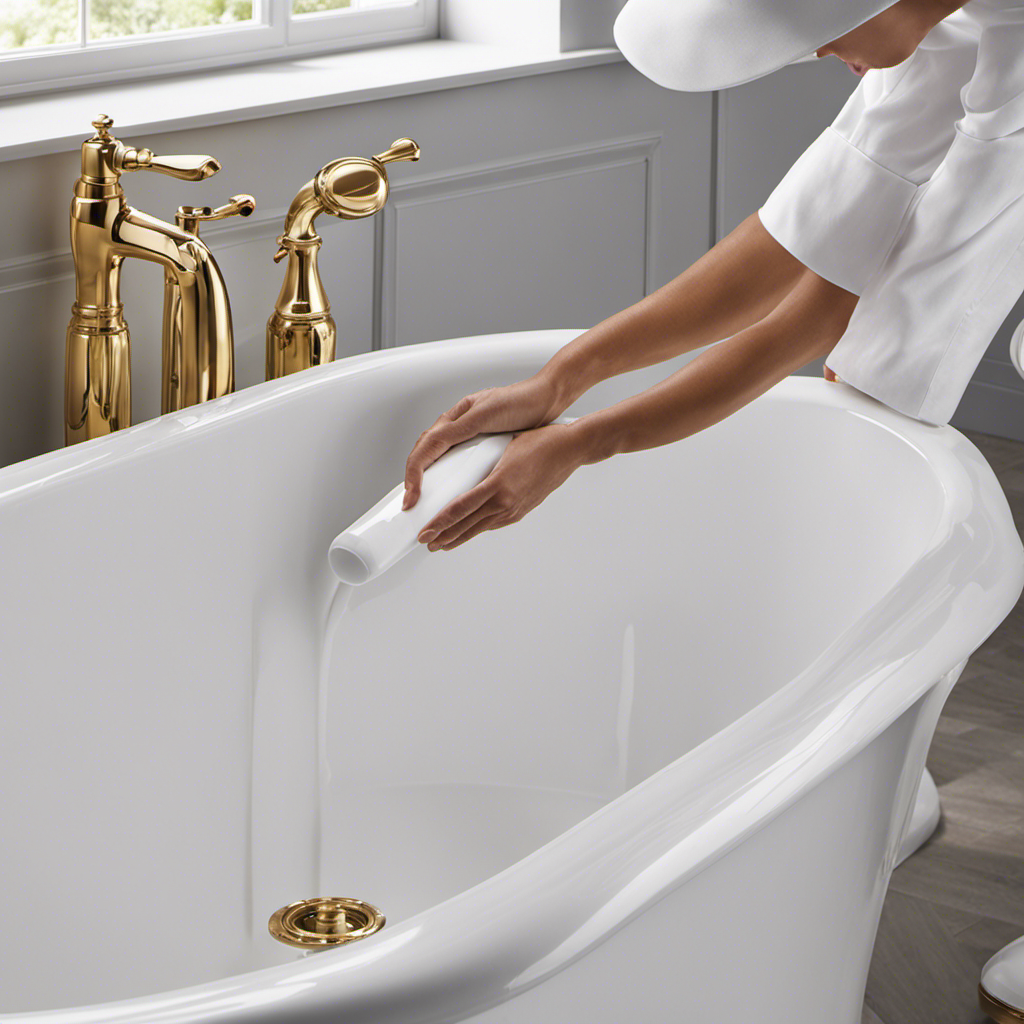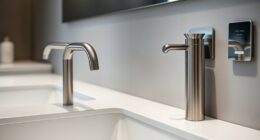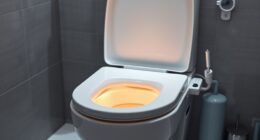So, you’ve found yourself with a clogged bathtub, huh? Well, fear not, because I’ve got just the solution for you.
In this step-by-step guide, I’ll show you how to clear that stubborn clog and get your tub back to its sparkling clean state.
From the common causes of bathtub clogs to the tools and supplies you’ll need, I’ve got you covered.
So, grab your plunger and let’s dive in!
Key Takeaways
- Hair accumulation and soap scum buildup are common causes of bathtub clogs.
- Signs of a bathtub clog include slow drainage, standing water in the bathtub, gurgling sounds from the drain, foul odor from the drain, and water backing up into other fixtures.
- DIY methods to clear bathtub clogs include using a plunger, pouring boiling water down the drain, using a mixture of baking soda and vinegar, and using a plumbing snake or wire hanger to remove the clog.
- Chemical drain cleaners should be used with caution as they can damage pipes, may not effectively remove the clog, can be harmful to the environment, and cause skin and eye irritation. It’s best to call a professional if DIY methods fail, multiple drains are clogged, there is a foul odor or sewage backup, there is a history of plumbing issues, or there have been unsuccessful attempts to clear the clog.
Common Causes of Bathtub Clogs
You’ll want to know the common causes of bathtub clogs so that you can prevent them in the future. Hair clogs and soap scum are two of the most frequent culprits behind a clogged bathtub drain.
Hair can easily get tangled and accumulate in the drain over time, leading to a blockage. Soap scum, on the other hand, is formed when soap mixes with minerals in the water and forms a sticky residue that can build up in the pipes. Both of these substances can restrict the flow of water and cause a backup in the bathtub.
Understanding these common causes will help you take preventive measures to keep your drain clear and flowing smoothly.
Now, let’s move on to the tools and supplies needed for clearing bathtub clogs.
Tools and Supplies Needed for Clearing Bathtub Clogs
To tackle the issue, gather the necessary tools and supplies for removing the obstruction in your tub. Here’s a step-by-step guide to help you clear your bathtub clog:
-
Plunger: A plunger is a handy tool for dislodging minor clogs. Make sure you have a plunger with a flat bottom, specifically designed for tubs.
-
Drain snake: For more stubborn clogs, a drain snake can be effective. Insert the snake into the drain and twist it to catch and remove the blockage.
-
Baking soda and vinegar: Create a natural concoction by mixing equal parts baking soda and vinegar. Pour this mixture down the drain, let it sit for 15 minutes, then flush it with hot water to dissolve the clog.
-
Wet/dry vacuum: If none of the above methods work, a wet/dry vacuum can be used to suck out the clog.
Step-by-Step Guide to Clearing a Bathtub Clog
Start by gathering the necessary tools and supplies for removing the obstruction in your tub. To clear a bathtub clog, you’ll need a plunger, a drain snake, a bucket, and some gloves.
First, put on your gloves to protect your hands.
Then, remove the drain cover and use the plunger to create a strong seal around the drain. Push and pull the plunger vigorously to create suction and dislodge the clog.
If the plunger doesn’t work, try using a drain snake. Insert the snake into the drain and twist it to break up the clog. Pull out any debris you encounter.
Once the clog is cleared, run hot water down the drain to ensure it’s flowing freely.
Natural DIY Solutions for Clearing Bathtub Clogs
When it comes to clearing bathtub clogs naturally, there are a few key techniques that can be effective.
One popular method involves using a combination of vinegar and baking soda. By pouring these two ingredients down the drain and allowing them to react, they can help break down any clogs that may be causing the blockage.
Another technique is the hot water flush. This involves pouring boiling water down the drain to help melt away any built-up debris.
Lastly, the plunger technique can be used to create suction and dislodge the clog.
Vinegar and Baking Soda
Mix vinegar and baking soda together to create a powerful solution for clearing your bathtub clog. Here’s how to do it:
- Measure out 1 cup of baking soda and pour it down the drain.
- Follow it up with 1 cup of vinegar.
- Quickly cover the drain with a plug or towel to trap the fizzing reaction inside the drain.
- After about 30 minutes, remove the cover and flush the drain with hot water.
Using vinegar and baking soda is a great alternative to harsh chemical drain cleaners. Not only is it effective in breaking down clogs, but it’s also safe for your pipes and the environment. However, if the clog persists, it may be time to consider professional plumbing services. They have the expertise and tools to handle stubborn clogs and ensure your bathtub drains properly.
Now, let’s move on to the next step: the hot water flush.
Hot Water Flush
To complete the hot water flush, you’ll need to remove the cover or towel from the drain after about 30 minutes. This method works by using boiling water to break down and flush away the clog in your bathtub drain. It’s a simple yet effective way to clear minor clogs without using any harsh chemicals.
Here’s a step-by-step guide on how to perform a hot water flush:
- Boil a large pot of water on your stovetop.
- Carefully pour the boiling water directly into the drain.
- Let the hot water sit in the drain for about 30 minutes.
- After 30 minutes, remove the cover or towel from the drain.
- Turn on the hot water tap to flush out any remaining debris.
This method is safe for most types of drains and can be repeated if necessary. It’s a natural alternative to chemical drain cleaners, making it a healthier option for both you and the environment.
Plunger Technique
If you’re dealing with a stubborn drain blockage, try using a plunger to create suction and dislodge the obstruction. Here’s a step-by-step guide on using a plunger to unclog your toilet or bathtub drain:
- Start by covering the drain hole with the plunger, ensuring a tight seal.
- Push down on the plunger to create suction, then pull up forcefully to dislodge the blockage.
- Repeat this plunging motion several times, maintaining a strong seal.
- Once the clog is cleared, test the drain by running water to ensure it flows freely.
If the plunger doesn’t work, you might need to consider using a drain snake. A drain snake is a flexible tool that can be inserted into the drain to break up and remove stubborn clogs. Follow the instructions that come with the drain snake for best results.
Preventative Measures to Avoid Bathtub Clogs
Make sure you regularly clean the bathtub drain to prevent clogs from forming.
One of the main causes of bathtub clogs is hair buildup. To prevent this, consider using drain covers that can catch the hair before it goes down the drain. These covers are easy to install and can be found at most hardware stores.
Simply place the cover over the drain opening and secure it in place. The cover will catch the hair, preventing it from entering the drain and causing clogs. It’s important to clean the drain cover regularly as well to ensure it continues to function effectively.
By taking these preventative measures, you can greatly reduce the chances of experiencing a bathtub clog.
However, if you do find yourself dealing with a stubborn clog, it may be time to call a professional for bathtub clog removal.
When to Call a Professional for Bathtub Clog Removal
When you’re unable to remove a stubborn bathtub clog on your own, it’s time to call in a professional.
Here are four signs that indicate it’s time to hire a professional for bathtub clog removal:
-
Persistent Clogging: If you’ve tried various DIY methods and the clog keeps coming back, it’s a clear sign that the problem is deeper than you initially thought.
-
Slow Drainage: If water takes forever to drain from your bathtub, even after attempting to clear the clog, it’s a sign that there could be a more serious blockage in the pipes.
-
Foul Odors: If there is a persistent foul smell coming from your bathtub drain, it could indicate a buildup of debris, hair, or even mold. A professional can help identify the cause and eliminate the odor.
-
Multiple Clogs: If multiple drains in your home, including the bathtub, are experiencing clogs, it could be a sign of a larger issue within your plumbing system that requires professional attention.
When hiring a professional for bathtub clog removal, look for someone who is licensed, experienced, offers a warranty on their work, and has positive customer reviews.
Conclusion
In conclusion, clearing a bathtub clog may seem daunting, but with the right tools and knowledge, it can be a manageable task. By following the step-by-step guide provided in this article, you can effectively unclog your bathtub and restore its functionality.
However, it is important to note that preventative measures are key to avoid future clogs. Did you know that according to a survey conducted by a plumbing association, 80% of bathtub clogs are caused by hair buildup? This statistic emphasizes the importance of regularly cleaning out hair from your drain to prevent clogs.
Remember, if all else fails, don’t hesitate to call a professional for assistance.










